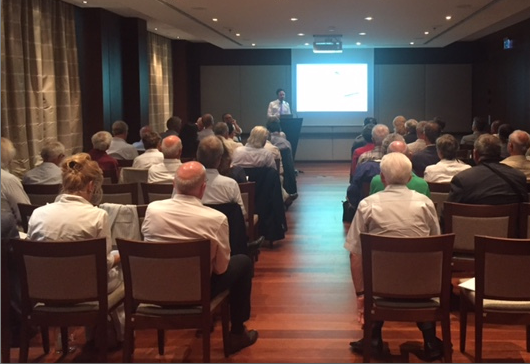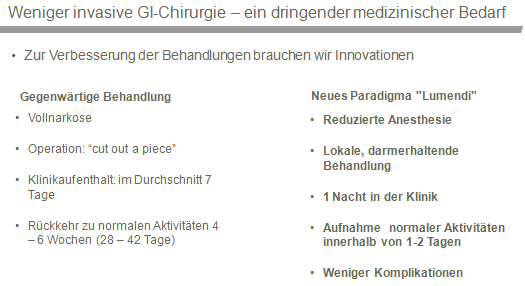Zusammenfassung auf Deutsch gibt es weiter unten. Ebenfalls Slides zum Anschauen. Synopsis of our Lumendi Ltd. event, including slides for your perusal.
Recently, a few people got together to learn more about the Endolumenal Surgical Platform (ESP) developed by Lumendi Inc.
In short, ESP is a medical device that dramatically increases current endoscopes‘ capabilities. It enables the performance of many more procedures entirely via the lumen of the colon, which is minimally invasive compared to open or laparoscopic surgery.
For this event, we had three presenters:
– Gerd Silberhumer, Surgical Oncologist at Universitätsklinik Wien (Vienna General Hospital) and member of the Lumendi Medical Advisory Board (medical matters)
– Dr. Peter Johann, Chairman Lumendi Ltd (product pipeline, strategy and timetable)
– Professor Urs E. Gattiker, PhD (moderator, cost-benefit data)
Of particular interest at this well-attended event was the Question & Answer session toward the end of the presentation. Discussions continued during the reception held immediately following.
We hope to have another of these events soon.
What do you like most about minimally-invasive medical technology?
Have a question? Just ask us below, and we will answer!
Zusammenfassung
Abo bestellen für den Lumendi Newsletter (1 bis 2 x im Monat)
Diese Woche hatten wir die Ehre, einigen Interessierten (siehe Foto oben) unsere Endoluminale Chirurgische Plattform (ESP) vorstellen zu dürfen.
Die Vorteile der Technik sind auf der rechten Seite in der Grafik unten skizziert.
Es war ein heisser Tag in Zürich mit über 35 Grad Celsius. Trotzdem hatten sich viele Leute die Mühe gemacht, unseren Event zu besuchen. Das freute uns natürlich sehr.
Wir hatten 3 Referenten:
– Gerd Silberhumer, Surgical Oncologist Universitätsklinik Wien Lumendi Medical Advisory Board (medizinische Aspekte)
– Dr. Peter Johann, Chairman Lumendi Ltd. (Produkte Pipeline, Strategie und Zeitplan)
– Professor Urs E. Gattiker, Ph.D. (Moderator, Kosten-Nutzen, Daten)
Sie können die Slides gleich hier ansehen:
[slideshare id=50310135&doc=lumendi-symposium-juli-7-insights-150708162200-lva1-app6891]
Nach dem formalen Teil ging es dann zum Empfang mit Imbiss. Teilnehmer/Innen nutzten die Zeit auch zu angeregten Gesprächen. Dabei ging es um das ESP wie auch andere interessante Dinge.
Wir hoffen, dass wir bald wieder einen solchen Event organisieren können.



This looks like another innovation in healthcare that could really have a positive impact concerning service delivery, patient safety and improved quality of life because of faster recovery.
Reading the blog post and checking the slides I was wondering what patients are saying about the procedure and the usability (on them) of the new device?
Clearly, less complications leading to improved health outcomes are impressive. How do they experience the technology?
Looking forward to reading from you – and by the way, great blog start, I do like the SlideShare element.
Best, Joerg
Dear Joerg
Thanks so much for your comment on this blog entry. Of course, we take the praise with a smile 🙂 a big smile. We will try to have slides and video clips on a regular basis.
Regarding your question:
„I was wondering what patients are saying about the procedure and the usability (on them) of the new device?“
Slide Nr. 16 gives you an idea about the timeline for this device.
We have prototypes and are currently finalising these. But it will take a few more months before we are in full production.
Minimally-invasive surgery is generally very popular with patients. However,
– having fewer days in hospital (1 instead of up to 7) and
– a shorter time to recover at home (2 instead of 28-42 days to be able to use your moutainbike again, for instance)
I find this great for several stakeholders including hospitals, medical staff, patients and the health care system in general (lower costs).
I hope this answer is useful to you and please, stop by again we love reader comments.
Urs
Dear Urs,
thanks for the addtional information on the timeline. I also agree that innovative technology goes hand in hand with improved quality of life — I do love the biking example.
However, being no expert in minimal invasive surgery I would still like to learn more about the challenges that accompany these new technologies. What about infection rates? What about interface problems along the care continuum (reducing hospitals days often means less time for patient education etc.)?
In general, I am convinced this is the right direction. Just wondering about other pieces in the puzzle…
Kind regards, Joerg
Joerg, just a quick reply on infection rates.
These ad on devices should not have any impact on infection rates. They will be the same as in currently established endoscopy.
Depending on what type of procedures will be performed with them, infection rates can even reach those of surgical procedures.
Hope this is useful
Gerd
Thanks for the input, Gerd, very helpful indeed!
Lieber Gerd und Joerg
Thanks for stopping by and taking time out of your busy schedule to join this conversation.
I find Gerd’s point interesting that infection rates with endonumenal procedures can be as high as with surgical procedures. But according to the Nationale Strategie zur Reduktion von Spital- und Pflegeheiminfektionen (Strategie NOSO) (click to READ), in Switzerland about 70,000 people catch infections at hospitals each year.
About 2,000 die because of this.
NOSO suggests 20 to 50% of these infections are unnecessary and could be prevented.
Therefore:
– a shorter hopsital stay
can help in reducing the patient’s exposure to possible bugs that could result in infections.
That in itself makes the technology add-on attractive for patients.
It makes it feasible to go home the same day or a day later after the endonumenal surgery happened.
This in contrast to the 7 days of a hopsital stay other gastrointestinal procedures can require.
Thanks for sharing
Urs
Thanks for your comments, they are spot on with the vision of Lumendi to develop new approaches and devices enabling minimally invasive GI interventions.
We will pursue our development plan as fast as reasonably possible to bring these devices through the approval process and to the patients to achieve all the benefits you described before.
Peter Johann, Chairman Lumendi
Thanks for the update, Peter, looking forward to hearing more about this in the not too distant future.
I am particularly interested in the user experience and how patients are included in the service design. You can tell because of my interest in co-production of health: http://blog.careum.ch/blog/koproduktion-2/
Does that make any sense from your perspective, meaning from the private sector?
Kind regards, Joerg
Dear Joerg,
Highly interesting link you are providing!
I definitely agree with you that patients should get involved in the different possibilities of treatment they could receive to appropriately address their health issues. Nevertheless there are still plenty of patients who accept doctors‘ opinion as the „holy gral“.
Our devices will enable and simplify currently challenging endoluminal procedures. Further they will push the limits further. As well, they will allow the treatment of certain diseases endoluminally, that have required classical surgical procedures so far.
I am pretty sure patients are more likely to ask for minimal invasive procedures in the future. They will search the internet and make up their mind where they can get the best available treatment for their current problem and will no longer follow the „first advise“ of their primary care taker.
Nevertheless I still believe proper medical consenting and detailed discussion on treatment alternatives remain the key issues in best medical care.
Kind regards
Gerd Silberhumer, member of the medical advisory board
Dear Gerd,
I fully agree with your statements and thanks for the feedback.
In my humble opinion it is imperative to successfully link innovative treatment possibilities (like your advanced technology) with adequate health communication / shared-decision making. This helps us in coming up with the most patient-centred treatment option. In turn, the latter is then guided by patient education and self-management support, to further improve the outcomes of the treatment.
Best wishes,
Joerg